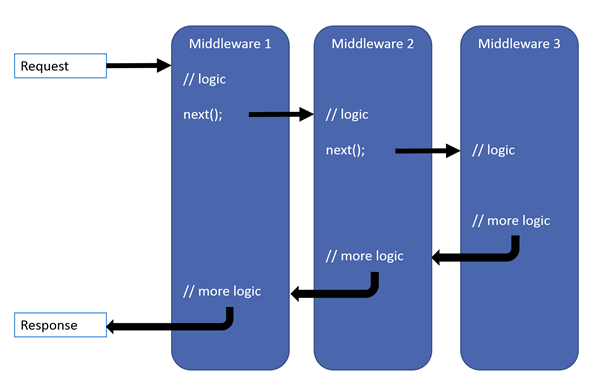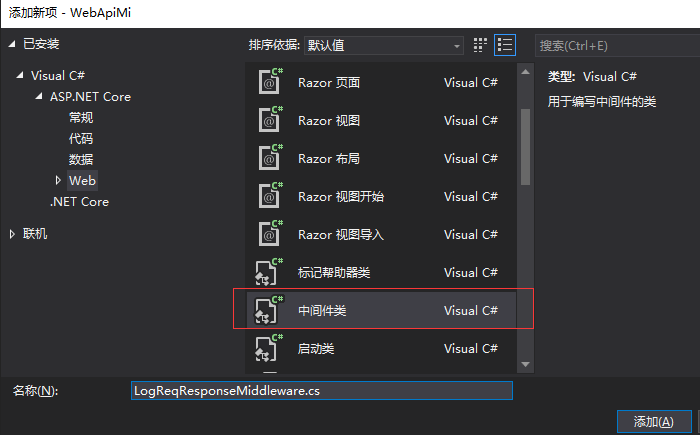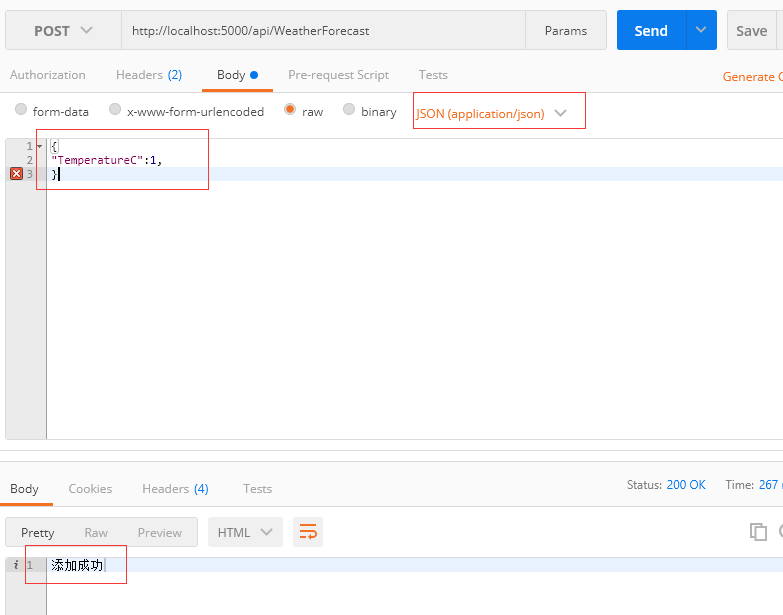中间件官网文档解释:中间件是一种装配到应用管道以处理请求和响应的软件 每个中间件:
- 选择是否将请求传递到管道中的下一个组件。
- 可在管道中的下一个组件前后执行工作。
使用 IApplicationBuilder 创建中间件管道
ASP.NET Core 请求管道包含一系列请求委托,依次调用。 下图演示了这一概念。 沿黑色箭头执行。

IApplicationBuilder提供了三个扩展方法配置请求委托
- app.Run 作用添加一个终端中间件,因为不在向下传递请求,常常公开在管道末尾运行。实例代码
app.Run(async context => { await context.Response.WriteAsync("Hello, middleware!"); });
- app.Use 将多个请求委托链接在一起。next 参数表示管道中的下一个委托。 可通过不 调用 next 参数使管道短路等同于aap.run。 通常可在下一个委托前后执行操作,如以下示例所示:
app.Use(async (context, next) => { // 传递前操作 await next.Invoke(); // 传递前操作 }); app.Run(async context => { await context.Response.WriteAsync("Hello from 2nd delegate."); }); }
- Map 扩展用作约定来创建管道分支。 Map 基于给定请求路径的匹配项来创建请求管道分支。 如果请求路径以给定路径开头,则执行分支。实例代码如下
private static void HandleMapTest1(IApplicationBuilder app) { app.Run(async context => { await context.Response.WriteAsync("Map Test 1"); }); } private static void HandleMapTest2(IApplicationBuilder app) { app.Run(async context => { await context.Response.WriteAsync("Map Test 2"); }); } public void Configure(IApplicationBuilder app) { app.Map("/map1", HandleMapTest1); app.Map("/map2", HandleMapTest2); app.Run(async context => { await context.Response.WriteAsync("Hello from non-Map delegate. <p>"); }); }
自定义中间件
以下演示记录api输入输出参数的中间件。
1.创建一个webapi项目,在默认的WeatherForecastController控制器中添加一个简单的post方法,代码如下
[HttpPost] public string PostWeatherForecast([FromBody]WeatherForecastA weatherForecastA) { return "添加成功"; }
public class WeatherForecastA { public int TemperatureC { get; set; } }
2.新建一个中间件类.CS文件如图

选择之后默认代码如下:
// You may need to install the Microsoft.AspNetCore.Http.Abstractions package into your project public class LogReqResponseMiddleware { private readonly RequestDelegate _next; public LogReqResponseMiddleware(RequestDelegate next) { _next = next; } public Task Invoke(HttpContext httpContext) { return _next(httpContext); } } // Extension method used to add the middleware to the HTTP request pipeline. public static class LogReqResponseMiddlewareExtensions { public static IApplicationBuilder UseLogReqResponseMiddleware(this IApplicationBuilder builder) { return builder.UseMiddleware<LogReqResponseMiddleware>(); } }
脚手架自动帮我们创建一个 Invoke方法,传递给下一个中间件。一个将自定义的中间件添加到了http请求管道的扩展方法UseLogReqResponseMiddleware。
上面invoke不是异步的,我们自己可以改动,以下代码展示 一个api请求的输入参数和输出信息的日志打印
// You may need to install the Microsoft.AspNetCore.Http.Abstractions package into your project public class LogReqResponseMiddleware { private readonly RequestDelegate _next; public LogReqResponseMiddleware(RequestDelegate next) { _next = next; } public async Task Invoke(HttpContext httpContext, ILogger<LogReqResponseMiddleware> logger) { var request = httpContext.Request;
request.EnableBuffering(); //把请求body流转换成字符串 string bodyAsText = await new StreamReader(request.Body).ReadToEndAsync();//记录请求信息 var requestStr = $"{request.Scheme} {request.Host}{request.Path} {request.QueryString} {bodyAsText}"; logger.LogDebug("Request:" + requestStr); request.Body.Seek(0, SeekOrigin.Begin); var originalBodyStream = httpContext.Response.Body; using (var responseBody = new MemoryStream()) { httpContext.Response.Body = responseBody; await _next(httpContext); var response = httpContext.Response; response.Body.Seek(0, SeekOrigin.Begin); //转化为字符串 string text = await new StreamReader(response.Body).ReadToEndAsync(); //从新设置偏移量0 response.Body.Seek(0, SeekOrigin.Begin); //记录返回值 var responsestr = $"{response.StatusCode}: {text}"; logger.LogDebug("Response:" + responsestr); await responseBody.CopyToAsync(originalBodyStream); } } } // Extension method used to add the middleware to the HTTP request pipeline. public static class LogReqResponseMiddlewareExtensions { public static IApplicationBuilder UseLogReqResponseMiddleware(this IApplicationBuilder builder) { return builder.UseMiddleware<LogReqResponseMiddleware>(); } }
然后在Startup类的Configure方法中添加下面一行代码,把自定义的中间添加到了HTTP请求的管道中。
app.UseLogReqResponseMiddleware();//记录http请求 输入、输出值;
我们在postman中模拟请求

控制台上打印的信息如下:
